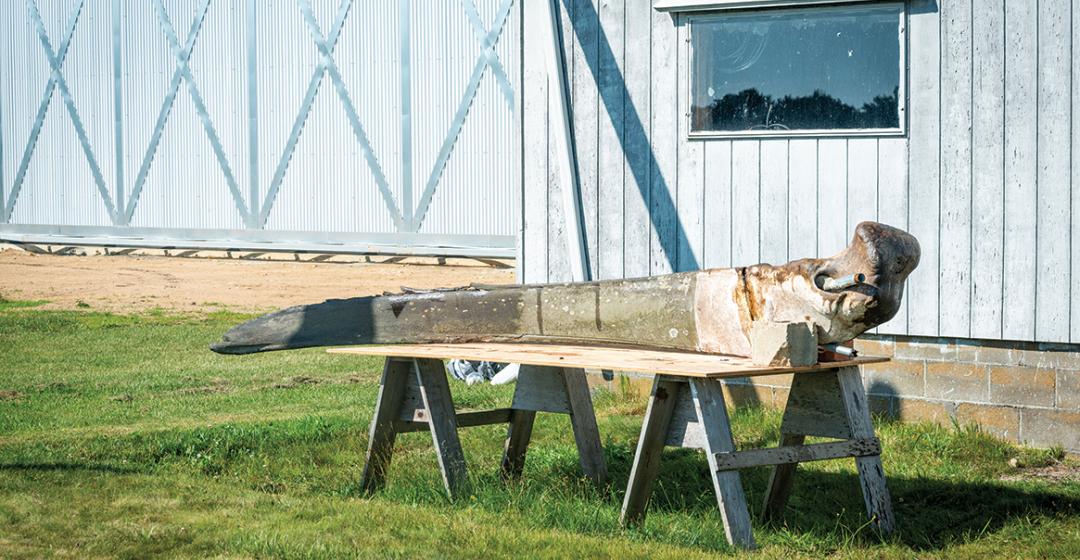Several weeks ago, I heard a tantalizing tale about “almost certainly a sperm whale” that washed ashore on South Beach in the 1950s. I envisioned a spectacular sperm whale, the kind of mankiller that Herman Melville immortalized in Moby Dick. According to the teller of the tale, fortune-seeking Vineyarders rushed to the shore to try to scoop out of the whale’s skull a substance called spermaceti, which was distilled into the oil that lit lamps prior to electric lamps. Contact Steve Gentle and his nephew Mike Creato, I was told, to hear not only the full whale tale but also the story about Creato’s effort today, seventy years later, to restore the whale’s jawbone.
And so my own personal whale hunt began. I visited Gentle, eighty-eight, at his Edgartown home, a kind of museum to the world of the sea: fishing, sailing, and whaling. On the living room mantel: an antique whaling harpoon. In the dining room: two statues of whales. On the stairs to the basement: Gentle’s three jigsawed models of whales. On the back of his 2006 Volvo: a license plate that features the tail of a whale. On the garage stairs to his second-floor collection of sea memorabilia: a hand-carved oar from a whaling boat that serves as a handrail.
In Gentle’s version of the story about the washed-ashore sperm whale, his father, also named Steve Gentle, went to the shore with his dog Birdie. The dog came across a piece of low-grade ambergris. Ambergris is secreted by the bile duct in the intestines of the sperm whale. Though foul-smelling, it is, ironically a highly valued fixative that permits sweet scents of perfumes to last longer. A high-grade 280-pound piece of ambergris was valued in 2021 at $1.5 million.
The hordes of Islanders who were digging into the whale carcass were looking for more ambergris, not spermaceti, Gentle recalled his father saying. “It was like the gold rush,” he said.
I ran into a problem with the story of the sperm whale, however, when I visited Mike Creato, sixty-one, in his biplane hangar at Katama Airfield, a cluttered building that is a different kind of museum than Gentle’s. Looking down on a thirteen-foot whale jawbone and a 1940 Waco biplane (“mostly operational,” said Creato) are old photos of John Wayne, Mickey Mantle, and Joe Louis, and a poster advertising a Frank Sinatra concert in Las Vegas on July 4, 1947.
Looking down on the jawbone myself, however, left me confused. I thought sperm whales had teeth. Melville writes in Moby Dick about sketches of whales “graven by the fishermen on Sperm Whale teeth.”This old bone was toothless.
I emailed eight photos of it to Michael J. Moore, a veterinary scientist at the Woods Hole Oceanographic Institution who recently published We Are All Whalers: The Plight of Whales and Our Responsibility (University of Chicago Press, 2021). “Sperm whale bones each have a row of teeth sockets – maybe 1.5” diameter and 3” deep,” he wrote back. “Not a sperm whale. Way too long too.”
So, the jawbone comes from what kind of whale? “It is the lower jawbone, or mandible, of a baleen whale,” Moore said. “Hard to get a sense of size from the photos, but it is either a humpback, sei, or fin whale most likely.”
I think of Gentle’s description of the Islanders who wanted to cash in on the insides of what they thought was a sperm whale, but was not: “It was like the gold rush.” And, in turn, I think of a young Mark Twain moving west to the Nevada Territory after hearing stories about prospectors making fortunes. Instead of gold, Twain discovered only quartz with flecks of mica and pyrite, known as fool’s gold.
The decaying innards of the alleged sperm whale were the Vineyarders’ fool’s gold. The June 11, 1954, Vineyard Gazette reports biologist Harry Turner of the Oceanographic Institution determined that the so-called ambergris was “completely different” from real ambergris. The article offers an intriguing theory: the South Beach whale’s remains were all that was left of a whale that washed up on the Rhode Island shore and was “towed back to sea” and “blown up by the Coast Guard.”
Regardless of the whale’s origin, I greatly admire Creato’s restoration of the jawbone, which has been on display outside the Katama Airfield snack bar for the past seventy years. The bone is brittle and broken, made worse by seven decades of exposure, but an object from nature of beauty. It is a tribute to Steve Gentle Sr. and others who bothered to lug it up from the beach on an old weapons carrier and preserve it. (Though it is now illegal to keep a whale bone, it was not at the time.) It is also a reminder of Martha’s Vineyard history, both in the mid-nineteenth century, when whaling was key to the local economy, and in the mid twentieth, when money was so hard to come by on the Island that a dead leviathan could draw droves of locals to the beach with shovels and sacks.
I can’t wait to see Creato install the restored whale jawbone, standing tall like a monument to Martha’s Vineyard, at the entrance to Katama Airfield.





